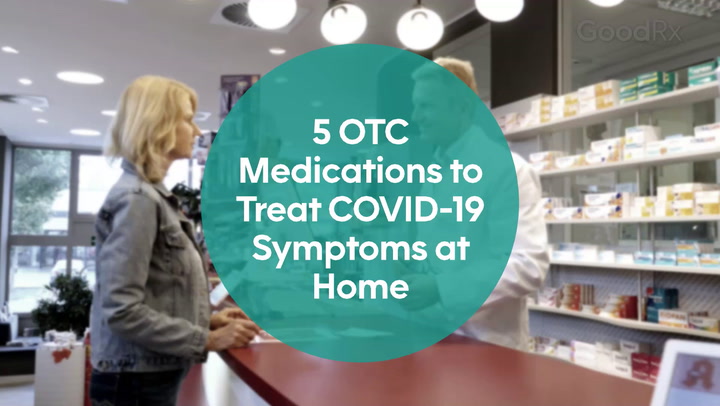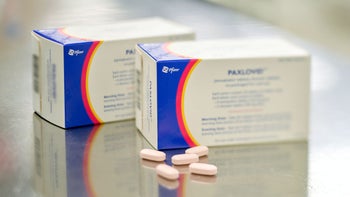
5 Paxlovid Side Effects You Should Know About
Key takeaways:
Paxlovid (nirmatrelvir / ritonavir) is an oral antiviral medication used to treat COVID-19 in people at high risk for severe illness. It has a few known side effects, but most are mild in nature.
A bitter or metallic taste in the mouth is the most common Paxlovid side effect. Others include diarrhea and headaches.
Paxlovid could cause liver damage. People with existing liver problems may have a higher risk of this serious side effect.
Access savings on related medications
Table of contents

Paxlovid (nirmatrelvir / ritonavir) has been a life-saver for many people with COVID-19. This antiviral medication is FDA approved for adults at high risk of developing severe illness from COVID. It’s also FDA authorized for high-risk adolescents age 12 and older who weigh at least 88 lbs. It’s considered the first-choice option for treating mild to moderate COVID in this group of people.
But as with all medications, Paxlovid has some side effects. While some are common, others are more unique.
What is Paxlovid?
Paxlovid is an antiviral medication that contains two active ingredients: nirmatrelvir and ritonavir. Nirmatrelvir helps prevent the virus that causes COVID from making copies of itself in your body. This gives your immune system a chance to catch up and kill the virus. Ritonavir boosts nirmatrelvir’s effects in the body, helping it to stay at ideal levels in your body for longer.
Save over 40% on Qsymia with GoodRx
Discover the once daily Qsymia for weight management. Qsymia is for adults and children 12-17 in combination with a healthy diet and regular exercise.

The standard dosage of Paxlovid is 2 tablets (300 mg) of nirmatrelvir and 1 tablet (100 mg) of ritonavir by mouth twice a day for 5 days. People with kidney problems may take a lower dosage to help lower the risk of side effects.
Certain people with liver problems may not be able to take Paxlovid. As we’ll discuss below, there’s a rare risk of liver damage with the medication. But your risk may be higher if you have existing liver problems.
Paxlovid side effects at a glance
Paxlovid is generally well tolerated. Its side effects are typically mild and should go away once you finish the medication. But it’s good to know what to expect while taking it.
Common Paxlovid side effects include:
A bad taste in the mouth
Diarrhea
Less common but generally mild Paxlovid side effects include:
Temporarily raised blood pressure
Headache
Abdominal pain
Nausea
Vomiting
A general feeling of discomfort
Rare but serious Paxlovid side effects include:
Liver damage
Serious skin reactions
Allergic reactions are also possible with Paxlovid. But these are very rare. Contact a healthcare professional if you think you’re having symptoms of an allergic reaction. But if you notice any severe or life-threatening symptoms, such as trouble breathing or swelling of the throat, seek immediate medical help by calling 911 or going to the ER.
What it feels like: Three people share their experiences with Paxlovid, which can be beneficial for many people at high risk from COVID.
Bad taste in the mouth: Paxlovid commonly produces a bitter or bad taste (sometimes called “Paxlovid mouth”). Find out why this side effect happens and how to manage it.
Interactions with other meds: Paxlovid interacts with hundreds of other medications. But many of these interactions can be managed with dosage adjustments.
Let’s take a look at five Paxlovid side effects and how to manage them.
1. Taste changes (‘Paxlovid mouth’)
Loss of smell or taste is a well-known symptom of COVID. But this Paxlovid side effect is different from that. As Paxlovid became more widely available, many people began reporting taste changes as a side effect. This experience was coined “Paxlovid mouth” by many news outlets. Those who experience it describe it in different ways, a couple being a bitter or metallic taste. But they all agree on one thing — it’s gross.
These taste changes were expected when Paxlovid was initially FDA authorized in 2021. In fact, it was the most commonly reported side effect during clinical trials. It’s also a common side effect of ritonavir (Norvir) — one of the two antivirals in Paxlovid. But even though it’s typical, that doesn’t mean it’s pleasant.
Thankfully, this Paxlovid side effect is temporary and relatively mild for many. It should go away once you stop treatment with Paxlovid, which usually only lasts 5 days. In the meantime, sucking on mints or strongly flavored candies may be helpful. If these taste changes are causing you to throw up, contact a healthcare professional.
2. Diarrhea
Diarrhea is a common side effect of many medications. While less common than taste changes, diarrhea is possible with Paxlovid (sometimes called “Paxlovid poop”). But keep in mind, diarrhea is also a possible symptom of COVID. So it can be hard to tell whether your diarrhea is coming from Paxlovid or COVID itself.
Diarrhea with Paxlovid can typically be managed at home. Be sure to drink plenty of fluids and watch for symptoms of dehydration. You may also find a bland diet sits better with you. If your diarrhea doesn’t clear up after finishing Paxlovid, reach out to a healthcare professional.
3. High blood pressure
It’s not unusual for a medication to raise blood pressure. And this can be a concern if you already have high blood pressure or other heart conditions. Small numbers of people who took Paxlovid have reported this side effect.
Your blood pressure should return to normal after finishing Paxlovid. But your healthcare team may ask you to check your blood pressure at home while taking it. Let them know if your blood pressure is still high after finishing the medication.
4. Headache
Headaches are no fun and can make it difficult to complete your usual activities. Paxlovid may cause headaches for some people who take it. But it’s relatively rare with the medication.
Headaches from Paxlovid should be mild. But if you find them bothersome, over-the-counter pain relievers may help. Acetaminophen (Tylenol) and ibuprofen (Advil, Motrin) are two options that don’t interact with Paxlovid.
5. Liver damage
As mentioned earlier, Paxlovid contains the medication ritonavir. Ritonavir is known to potentially contribute to liver damage. This side effect is more likely to happen in people who already have liver problems.
Liver damage wasn’t reported in Paxlovid’s clinical trials. But because of what experts know about ritonavir, Paxlovid is not recommended for people with severe liver problems. Make sure your healthcare team knows if you have a history of liver issues before you start taking it.
Seek immediate medical help if you experience any symptoms of liver damage:
Yellowing of the skin or eyes (jaundice)
Right-sided stomach pain
Dark urine
Nausea
Swelling in the stomach area
Frequently asked questions
No, Paxlovid shouldn’t make you sleepy. Drowsiness wasn’t reported by people taking the medication in clinical trials. But fatigue is a common symptom of COVID. It’s also one of the possible symptoms of long COVID. It’s more likely that the sleepiness you’re feeling is coming from the illness itself and not Paxlovid.
There are no foods that directly interact with Paxlovid. Even grapefruit juice (which interacts with many medications) is OK to combine with Paxlovid. But there are some foods you should avoid if you have COVID. Alcohol and highly processed foods can contribute to inflammation in the body. And this can negatively affect your body’s ability to fight infection.
You shouldn’t take Paxlovid if you have severe liver or kidney disease. You should also avoid it if you’re allergic to any of the active or inactive ingredients in the medication. But the most common reason people can’t take Paxlovid is because it interacts with other medications they already take. Paxlovid interacts with hundreds of medications. In some cases, a combination could cause serious complications. In those instances, you may need to avoid Paxlovid.
The bottom line
Paxlovid (nirmatrelvir / ritonavir) is an antiviral medication that can treat mild or moderate COVID-19. But while effective, it can cause some uncomfortable side effects. Taste changes and diarrhea are the most common Paxlovid side effects. Headaches and temporarily raised blood pressure are also possible.
Paxlovid side effects are typically mild and should stop after you finish taking it. Contact a healthcare professional if you’re experiencing anything severe or excessive during treatment.
Why trust our experts?


References
American Health Packaging. (2024). Ritonavir - ritonavir tablet, film coated [package insert].
Centers for Disease Control and Prevention. (2024). People with certain medical conditions and COVID-19 risk factors.
Centers for Disease Control and Prevention. (2024). Symptoms of COVID-19.
Hammond, J., et al. (2022). Oral nirmatrelvir for high-risk, nonhospitalized adults with COVID-19. The New England Journal of Medicine.
Infectious Diseases Society of America. (2024). IDSA guidelines on the treatment and management of patients with COVID-19.
MedlinePlus. (2023). Dehydration.
National Institute of Diabetes and Digestive and Kidney Diseases. (2019). Acute liver failure. LiverTox: Clinical and Research Information on Drug-Induced Liver Injury.
Pfizer Laboratories Division, Pfizer Inc. (2024). Paxlovid - nirmatrelvir and ritonavir [package insert].
Was this page helpful?
Related Articles
Browse medications
View AllResearch prescriptions and over-the-counter medications from A to Z, compare drug prices, and start saving.
























